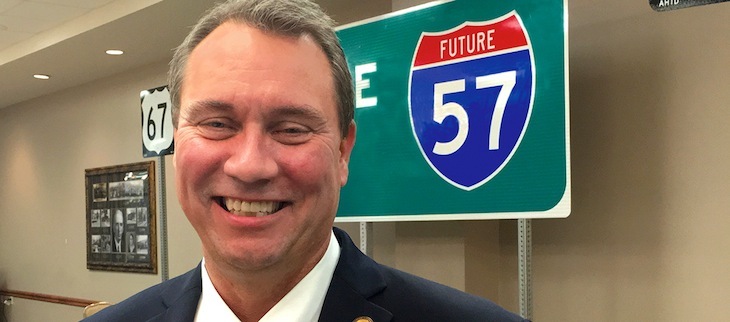Farmer: Highway funding about timing, perception, optics
by March 12, 2018 12:08 pm 883 views

Arkansas Highway Commission Chairman Alec Farmer.
Alec Farmer, owner of a family-owned farm and property and investment management company, is entering the third year of a 10-year term as a member of the Arkansas Highway Commission.
The lawyer, whose public service also includes being an original member of the Arkansas Agriculture Board and former chairman of the Arkansas Natural Resources Commission, recently sat down with Talk Business & Politics CEO Roby Brock to talk about highways and the future of Northeast Arkansas.
Roby Brock: There is an age-old debate for folks in the highway industry. Does the money follow the cars or does the money follow the roads? How do you approach the rural versus urban debate?
Alec Farmer: Obviously, we wish we had enough resources to take care of the entire system. Unfortunately, we don’t. As time has gone on, revenues remained flat, while expenses have gone up 150% in the last 20 years. As time has gone by, we find ourselves today in a situation where we really only have funds available to take care of half the system and maintain half the system. So, the question is, which half do you take care of?
Brock: Which half do you take care of?
Farmer: We try to put the money that has the biggest impact for safety, mobility, and efficiency for the least amount of dollars that each project can cost. We’ve got 80% of our money going to maintain the system. Of that 80%, we’ve got 90% going into maintaining what we call the primary highway network, which is 7,800 miles of highway, which is about 48% of the system. But it carries 92% of the cars, so we’re trying to have the biggest bang for the buck. If you’ve got 92% of the traveling public that you’re covering, that’s about the best we can do under the current circumstances.
What we try to focus on with rural roads is bridge safety. Me, being from East Arkansas, I’m a little bit more attuned to the problems of the rural community and the highway systems with two of our biggest industries in Arkansas being agriculture and tourism. One other point I’d like to make is a lot of these rural roads carry the most precious cargo of all twice a day on a bus. So, we really need to find some solutions here.
Brock: Let’s talk about funding solutions. The Highway Commission and the Department has made a conscientious decision to wait until 2019 to go to the Legislature to try to find something that might be more permanent or long term. Why that delay?
Farmer: First, to put something on a ballot, it costs money. So, we have stakeholders that traditionally support us in our efforts for highway funding.
A lot of those stakeholders are the same stakeholders who had already committed to the Tort Reform movement. So, I felt like it was unfair of us to go to them when they had already made a prior commitment to another effort and say, “Hey, help us, too.” I don’t think it would have helped anybody. I think it would have split focus. We certainly wouldn’t appreciate it if we had been the first one out there with a proposal and somebody else came in behind us.
The Legislature has a Tax Review and Relief Committee right now. We don’t want to step on their toes. They’ve got things they’re wanting to do. We did not want to get in conflict or any controversy with them on anything they were proposing, anything we may propose.
Then finally, timing, and perception, and optics. The peak of our Connecting Arkansas Program is going to be the summer of 2018. We’re going to have close to a billion dollars in projects going on. When you say you don’t have money for a new program and you’ve got all these projects going on, you’ve got mixed signals there.
Brock: Talk to me about Northeast Arkansas. We’re here at an I-57 event. How do you see Northeast Arkansas either connecting or reconnecting to the state in a way that it hasn’t in the past?
Farmer: Northeast Arkansas sits at a crossroads between the Memphis-Kansas City freight route. Of course, Little Rock, on Highway 67 to St. Louis and the 67 route, and with 57, you share that same route up to Poplar Bluff then it goes to over to Sikeston and hits 57 on to Chicago.
Earlier today, I was telling a story about my father, when he was on the Highway Commission. He came in and asked me to go for a ride with him one day, in 1985 in the summer. We got in the car, drove around, he didn’t say where he was going. We ended up here on the 67 White River Bridge, approach to it. He gets out of the car and just kind of stares in the distance at the bridge. He was extremely proud that Northeast Arkansas was going to be connected to the rest of the state, across that river, by a four-lane interstate quality highway.
The point I made today was this is not just a state regional project with Intestate 57 connecting from North Little Rock to Chicago. It’s a regional project for our nation. Goods, people, and product can move from Chicago and the Midwest to Dallas and the Southwest through that route. It’s a critical route because it has an existing Mississippi River Bridge Interstate.
Those things are worth their weight in gold. So, you have that existing asset there that’s being underutilized.
